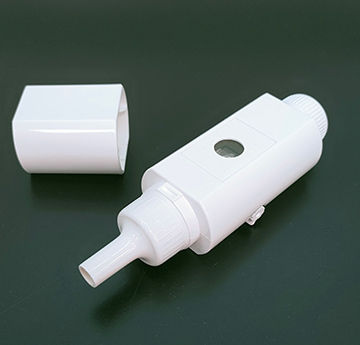
A research team from Nanyang Technological University has developed a handheld breathalyzer that, when analyzed using surface-enhanced Raman scattering, can reportedly test for COVID-19 infection with high sensitivity and specificity in less than five minutes. [Image: Shi Xuan Leong and Yong Xiang Leong, NTU]
A research team led by Xing Yi Ling at the Nanyang Technological University, Singapore, has unveiled a prototype for a point-of-care COVID-19 breath analyzer that, according to the group, can return accurate results in less than five minutes (ACS Nano, doi: 10.1021/acsnano.1c09371).
In clinical testing, the system—which combines a handheld breath-sample collector with a compact, portable Raman spectrometer—reportedly could distinguish COVID-positive from COVID-negative persons with greater than 95% accuracy. The researchers believe that the device could “play a significant role” in the scaling-up of COVID-19 testing, particularly in high-traffic settings requiring quick mass screening for the disease.
The need for fast mass testing
Most COVID testing today uses one of two techniques: reverse-transcription polymerase chain reaction (RT-PCR)—almost invariably cited as the “gold standard”—and rapid antigen testing. But for fast screening of people at large public events, both methods have their problems. RT-PCR, while sporting the highest accuracy, generally uses uncomfortable nasal swabs to snag a sample, needs to go to a lab for analysis and is slow to produce results. Antigen testing is much faster, but less accurate, plagued in particular by high false negatives.
These disadvantages have spurred the search for a simple COVID “breathalyzer” that can deliver accurate results on short timescales and without intrusive sample collection—a trifecta for mass-test scenarios. Such devices work fundamentally differently from RT-PCR and antigen-test methods. Instead, breathalyzers rely on previous research showing that the immune responses and metabolic changes wrought by the SARS-CoV-2 virus lead to changes in the concentration of certain volatile organic compounds (VOCs) in the patient’s exhaled breath.
Unfortunately, the standard approach for separating and analyzing these potential biomarkers in human breath, gas chromatography–mass spectrometry (CG–MS), commonly requires nonportable, costly instruments that are awkward to integrate into mass screening. Those disadvantages have spurred a search for a simpler and more portable breed of breathalyzer for COVID tests.
Quick results from SERS
To come up with a more mass-screening-friendly approach to a COVID breathalyzer, Ling’s team in Singapore targeted a device that would sense the disease through spectroscopy—specifically, by reading the weak Raman spectral shifts that would be apparent in a breath sample with the right combination and concentration of VOCs. To make the system practical, the researchers employed surface-enhanced Raman scattering (SERS), a method for boosting the otherwise faint, unreadable Raman shifts via light-field concentration at a plasmonic surface.
To come up with a more mass-screening-friendly approach to a COVID breathalyzer, the Singapore team targeted a device that would sense the disease through Raman spectroscopy.
The team began by chemically cooking up a large quantity of plasmonic silver nanocubes, with an average edge-on dimension of around 120 nm. The cubes were next steeped in a solution containing three substances—4-mercaptobenzoate (MBA), 4-mercaptopyridine (MPY) and 4-aminothiophenol (ATP)—known to chemically interact with and bond to specific VOCs that might be present in the patient’s breath. The researchers then spread the chemically functionalized nanocubes on an aluminum surface to create a sensor chip. The chip was in turn loaded into a small breathalyzer housing that was subsequently vacuum sealed.
In an actual breath test, the patient exhales into the breath chamber for 10 seconds, and the sample then sits idle for two minutes. This incubation period allows time for the organic molecules glued to the sensor chip’s functionalized nanocubes to grab onto VOC molecules in the breath sample. After that, the breathalyzer chip is popped into an off-the-shelf Raman spectrometer, which reads the SERS-enhanced signal from the chip to create a VOC profile of the patient’s breath. Finally, the VOC profile is automatically analyzed, using a classification algorithm designed for maximum discrimination between COVID-positive and COVID-negative results.
The entire process, according to the researchers, takes less than five minutes. It also requires little expertise or interpretation on the part of the testing staff, reading out a simple verdict: positive or negative. And the analysis step takes place separately from sample collection, which could be handy in situations requiring rapid throughput of large crowds.
Greater than 95% accuracy
The researchers tested the Raman breathalyzer system on 501 subjects, 427 of whom had tested negative for COVID-19 using RT-PCR and 74 of whom had logged a positive RT-PCR result for the disease (with or without actual disease symptoms). Using those results as a benchmark, the team found that its breathalyzer was 96.2% sensitive in picking up the patients who had tested positive for COVID in the RT-PCR test (equivalent to a 3.8% false-negative rate). The breathalyzer was even more effective in discriminating the patients who had tested COVID-negative by RT-PCR, with a 99.9% specificity (a 0.1% false-positive rate).
While trials suggest the breathalyzer’s sensitivity is slightly below the PCR standard, tests with the device can be conducted in less than five minutes—blazingly fast compared with RT-PCR.
While the false-negative rate in particular shows that the test isn’t quite up to PCR’s accuracy standards, the authors point out that their breath test can be conducted in less than five minutes—blazingly fast compared with RT-PCR. And they write that their test’s false-negative rate is “superior to commercially available antigen rapid tests with reported false-negative rates of 10−30%.” The trials also revealed, according to the team, that the test’s accuracy is independent of potential confounding factors such as age, gender and smoking habit.
Overall, the authors conclude that the test’s advantages could prove useful in “diverse settings and locations like schools, airports, and events like weddings, religious events, and conferences.” And they believe their work may lay the groundwork for similar breathalyzers for non-COVID disease.

